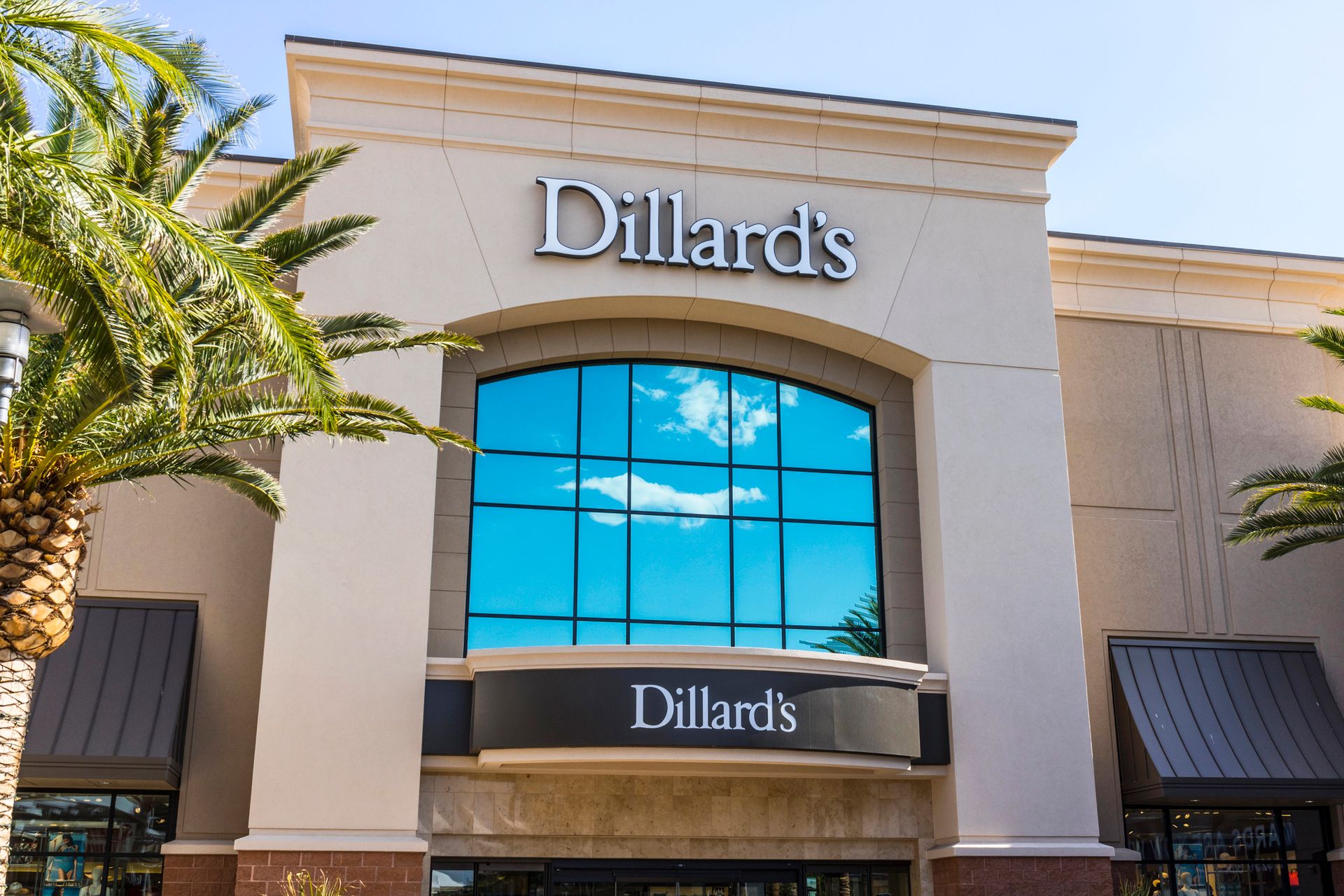When a retailer posts steady comps, fat cash, and keeps buying back stock, you pay attention.
The runway isn’t infinite in department-store land, but if you want exposure, this is the rare one still ringing the register.

New Leaders Rising (Sponsored)
Some stocks move the needle. Others change the game.
Our newest report highlights 5 companies with the potential to double.
Past reports uncovered monster runs—+175%, +498%, even +673%.¹
This edition is free, but the window closes at midnight.
[Click here to secure your copy now]
*This free resource is being sent by Zacks. We identify investment resources you may choose to use in making your own decisions. Use of this resource is subject to the Zacks Terms of Service.
*Past performance is no guarantee of future results. Investing involves risk. This material does not constitute investment, legal, accounting, or tax advice. Zacks Investment Research is not a licensed dealer, broker, or investment adviser.


Strategic Positioning
Dillard’s (NYSE: DDS) is not your mall-walker’s department store.
It leans hard into exclusive/private-label assortments and tight inventory discipline, which keeps markdowns in check and gross margin healthier than peers.
That’s been the quiet edge behind the outperformance.
Recent quarter check: sales were about $1.51B (+2% YoY) with comps roughly +1%. Categories like juniors, kids, and accessories showed traction while ladies’ apparel lagged.
EPS printed $4.66, well ahead of consensus, helped by operational efficiency and share count reduction.
Retail gross margin ticked down 100 bps to 38.1%, but stayed robust by sector standards.
The balance sheet is the real conversation starter: roughly $1.0B in cash vs. $226M in long-term debt.
Add a modest dividend (about $0.30 quarterly) and ongoing buybacks, and you’ve got an owner-friendly setup.
Strategically, Dillard’s has three levers most department stores struggle to pull at the same time:
Assortment control: Exclusive/private brands keep price integrity and give customers a reason to walk through your doors (or click your site).
Discipline > growth at any cost: Inventory and SG&A control let them protect margin even when top-line is mid-single digit at best.
Capital returns: They’re not hoarding cash. Repurchases and a small but steady dividend return capital while the business funds itself.

Action Plan
If you want retail cyclicality without gambling on a turnaround story, this one’s a cleaner way to play it.
Starter buy: Begin a position $570–$600 when the stock is catching its breath after pops.
Add on proof: Layer more > $610 if we see another comp-positive quarter with stable margin and continued buybacks.
Sizing: Keep it 2–3% of a diversified equity sleeve as it’s still a discretionary retailer.
Risk control: Consider trimming if price loses the $540–$550 area and fundamentals wobble (e.g., comps turn negative and margin compresses sequentially).

Poll: Which sector’s best days are behind it?

Final Phase Begins (Sponsored)
2025’s final quarter could be your best chance to capture major upside before 2026 resets the board.
Our analysts just released a free report uncovering 7 stocks built to thrive as volatility spikes — not collapse under it.
They’re in sectors seeing explosive momentum: AI, defense, and infrastructure.
You’ll get ticker details, entry zones, and catalysts for each — 100% free.
Download “Top 7 Stocks for Q4 2025” before this report

Recent Momentum
Shares have ripped ~65% over 12 months and ~32% YTD, hitting new highs along the way.
That’s not just multiple expansion; earnings revisions moved up (FY25 creeping to ~$30–31, FY26 toward the high-$20s), and Dillard’s has posted a string of estimate beats with an average surprise north of 20%.
Importantly, they’re doing it without stretching the balance sheet, and long-term debt keeps stepping down, and cash remains plentiful even after buybacks.
Digital and loyalty aren’t just buzzwords here; the omnichannel plumbing has quietly improved conversion and repeat rates.
You can see it in steady comps despite a tougher category backdrop.
Is everything perfect? No. Ladies’ apparel softness and a 100 bps gross-margin slip remind you this is still retail.
But the company keeps finding offsets (mix, exclusives, expense control) to hold the line.

Want to make sure you never miss a stock recommendation?
Elite Trade Club now offers text alerts — so you get trending stocks and market-moving news sent straight to your phone before the bell. Email’s great. Texts are faster.

The Setup You’re Actually Betting On
You’re underwriting execution plus capital allocation more than a top-line renaissance.
Execution: Clean inventories, higher full-price sell-through, and category mix that skews to areas with velocity (H2 tends to be kinder to accessories/seasonal footwear).
Capital allocation: Buybacks shrink the share count, amplifying EPS even if revenue is flattish to modestly up. With ~$1B in cash, they can stay opportunistic.
Defensive offense: Exclusive/private label and tight planning mean fewer clearance fire drills, preserving gross margin through cycles.
If comps stay slightly positive and margins hold near high-30s (on retail), EPS math still works without heroics.

Trade Picks (Sponsored)
I’d like to give you a free copy of our brand-new report: 7 Best Stocks for the Next 30 Days.
Since 1988, our proven stock-ranking system has more than doubled the S&P 500, generating average annual gains of +24.2%.
This just-released Special Report reveals the 7 most explosive stocks currently ranked as Strong Buys. Fewer than 5% of stocks ever qualify.
These could be the most exciting short-term trades you’ll see all month.
Don’t make your next move without seeing them first.

Valuation Check
At roughly 16–17x trailing earnings (forward often screens near ~20x given Street’s cadence), the stock isn’t cheap for a department store, but that comparison misses the point.
Versus peers, DDS earns the premium for:
Balance sheet strength (net cash posture after adjusting for modest debt),
Margin quality (upper-30s retail gross margin is rare air), and
Buyback cadence (steady, and meaningful over time).
On sales, it sits near ~1.2x P/S, which is elevated for the sub-industry, but again, this is the best house on a tough block.
If management keeps comps stable and costs tight, a high-teens multiple remains defendable; any upside surprise on comps or gross margin and you can justify ~18–20x next-twelve-month EPS.

Catalysts to Watch
Holiday cadence: Inventory freshness, promotions, and full-price mix through November/December.
Category mix shifts: Signs that ladies’ apparel stabilizes; continued strength in juniors, kids, and accessories.
Margin commentary: Markdown rates and freight/occupancy leverage, we want margin to flatten or expand, not drift down.
Capital returns: Pace of repurchases; any bump to the dividend (not core to the thesis, but a nice signal).
Store productivity: Remodels and selective closures, productivity per square foot matters more than raw store count.

Risks
Let’s call out the un-fun stuff:
Consumer softness: If discretionary spend tightens, comps dip and promotions creep up. The model can handle okay, but not a prolonged clearance cycle.
Category exposure: Ladies’ apparel weakness lasting into multiple quarters would pressure margin.
Sector stigma: Department stores trade with a structural discount; sentiment can swing hard on headlines that don’t apply 1:1 to DDS.
Tariffs/supply chain: Input costs or logistics spikes can nibble at gross margin if not offset by pricing or mix.
Concentration risk: A few categories carry outsized margin. If those stumble, there’s less room to hide.

Key Actions
Initiate on dips: Start $570–$600; keep dry powder for volatility.
Add on execution: Increase > $610 after another clean quarter (comps ≥ 0%, retail GM stable, buybacks ongoing).
Watchlist metrics: Comps by category, markdown rate, inventory growth vs. sales, SG&A leverage, cash vs. buyback outlays.
Guardrails: Reassess if comps turn negative and retail gross margin compresses >150 bps sequentially or if inventory growth outpaces sales for 2+ quarters.
Portfolio fit: Pair with staples or cash-flow names to balance retail cyclicality.

Final Take
Some retailers chase traffic with promos and hope the margin shows up later. This one starts with discipline and lets earnings fall out of the math.
With a fortress-ish balance sheet, steady buybacks, and a differentiated assortment strategy, it’s earned its premium within the sector.
You’re not buying a high-growth retailer, you’re buying operator quality and capital returns with enough top-line to keep the flywheel going.
If you want exposure to U.S. consumer spend without betting on a turnaround or a fashion fad, this is a pragmatic pick.
Build it on weakness, add on proof, and let the register do the talking.

That’s all for today. Thank you for reading. If you have any feedback, please reply to this email.
Best Regards,
— Adam Garcia
Elite Trade Club
Click here to get our daily newsletter straight to your cell for free.
P.S. Just like this newsletter, it's 100% free*, and you can stop at any time by replying STOP.




